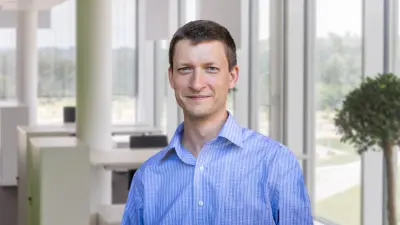Dr. Petra Sonnweber-Ribic
Senior expert for microstructural modeling (metals)

I’ve been focusing on the topic of computational material science as a research engineer since 2011. Right now, I am working as a senior expert on micromechanical fatigue simulation in metals. Together with a team, I am developing models of relevant factors influencing cyclic mechanical damage in materials and components. This allows us to make material lifetime predictions or identify micromechanical factors that are responsible for material damage. In this way, we are contributing to the reliability and sustainability of our products.
Please tell us what fascinates you most about research.
Research allows us to gain a principal understanding of the physical world. I have always loved understanding why and how things happen — from a very basic point of view. This understanding of underlying mechanisms and basic effects is the basis for improvements and progress. For example, this can be used to improve the mechanical properties of existing materials or to enable completely new applications. And that is incredibly exciting.
What makes research done at Bosch so special?
Bosch Research offers the chance to investigate important research questions with the necessary precision and at the same time the research focus is always linked to explicit applications. This combination makes the work extremely interesting and diverse. Due to the large number of Bosch business areas and components, these research questions are similarly diverse. This means that there are always new challenges and development topics.
What research topics are you currently working on at Bosch?
I am working on the micromechanical modeling of fatigue damage in metallic materials. Material fatigue is one of the most important failure mechanisms for mechanically loaded components. It therefore takes a huge effort, both in terms of duration and cost, to make sure that our components reach a certain lifetime or fatigue strength today. Therefore, understanding the damage mechanisms is the basis for targeted and efficient component development. The particular challenge of fatigue damage is that it is influenced by various factors: the surface of the component, residual stresses that occur, and most important the underlying microstructure. In an interdisciplinary team we are currently working on modeling all of these influences and their interplay with each other. We have already been able to predict lifetime scattering and reveal the influence of different material phases on damage using the existing approach.
What are the biggest scientific challenges in your field of research?
The term 'capturing physics' describes this very well. Despite increasing computing power, we cannot model materials at the most basic atomic level for insights into component-level mechanics today. This requires a summarized description of the relevant features, and therefore macro-level mechanical predictions are only possible through material descriptions and physically based models. Finding the right combination, so that the essential physical mechanisms are represented and the whole system can be calculated within a reasonable period of time — that is the great challenge for today's computational material science.
How do the results of your research become part of solutions “Invented for life”?
Computational predictions of material and component properties are an important step to significantly reducing development time and costs for new components. Furthermore, by revealing and modeling basic mechanisms and connections, we are contributing to the reliability and sustainability of our products.
Curriculum vitae
Since 2016
Senior expert, Micromechanical fatigue simulation in metals
2011
Research engineer, materials technology metals, Robert Bosch GmbH
2010
Ph.D., Textu.re in copper thin films, MPI for metal research
2004
Material Science (Dipl. Ing.), University of Stuttgart

Selected publications

E. Natkowski et al. (2022)
- Erik Natkowski, Petra Sonnweber-Ribic, Sebastian Muenstermann
- International Journal of Fatigue 159(1):106792

J. Kuhn et al. (2022)
- Jannick Kuhn, Matti Schneider, Petra Sonnweber-Ribic, Thomas Böhlke
- Springer Nature

Natkowski et al. (2021)
- Natkowski, E., Durmaz, A.R., Sonnweber-Ribic, P., Münstermann, S.
- International Journal of Fatigue, 2021, 152, 106418

Kuhn et al. (2021)
- Kuhn, J., Spitz, J., Sonnweber-Ribic, P., Schneider, M., Böhlke, T.
- Optimization and Engineering, 2021
Get in touch with me
Dr. Petra Sonnweber-Ribic
Senior expert for microstructural modeling (metals)


